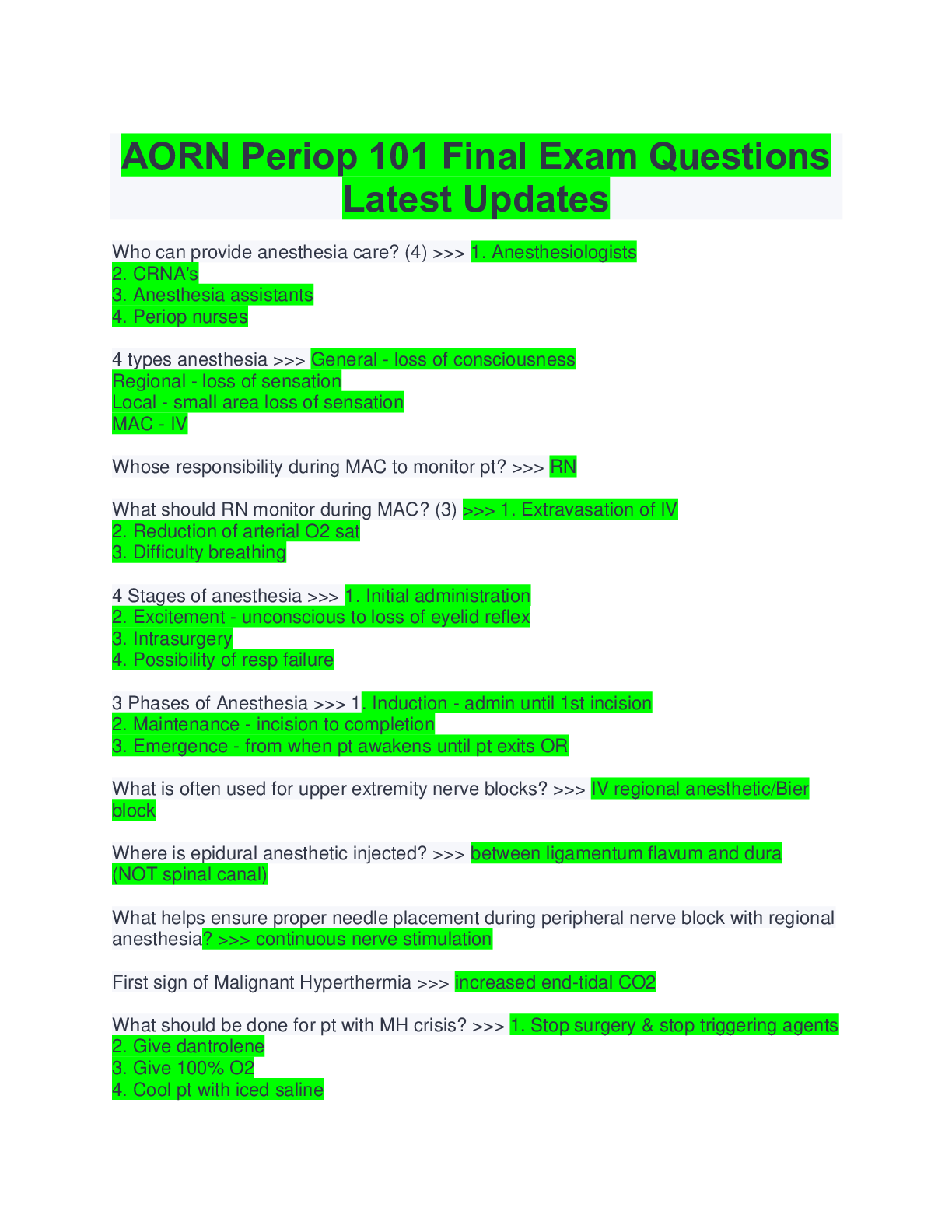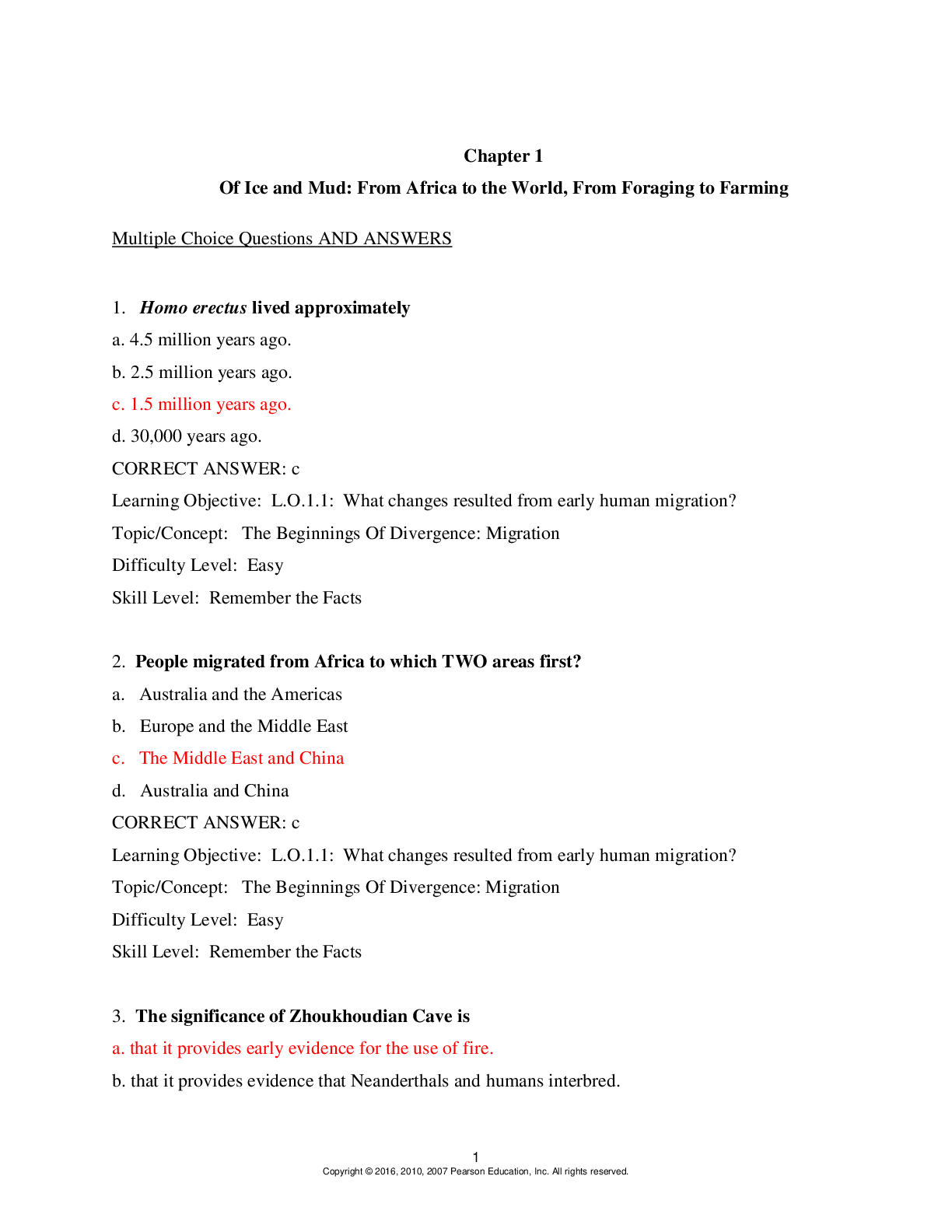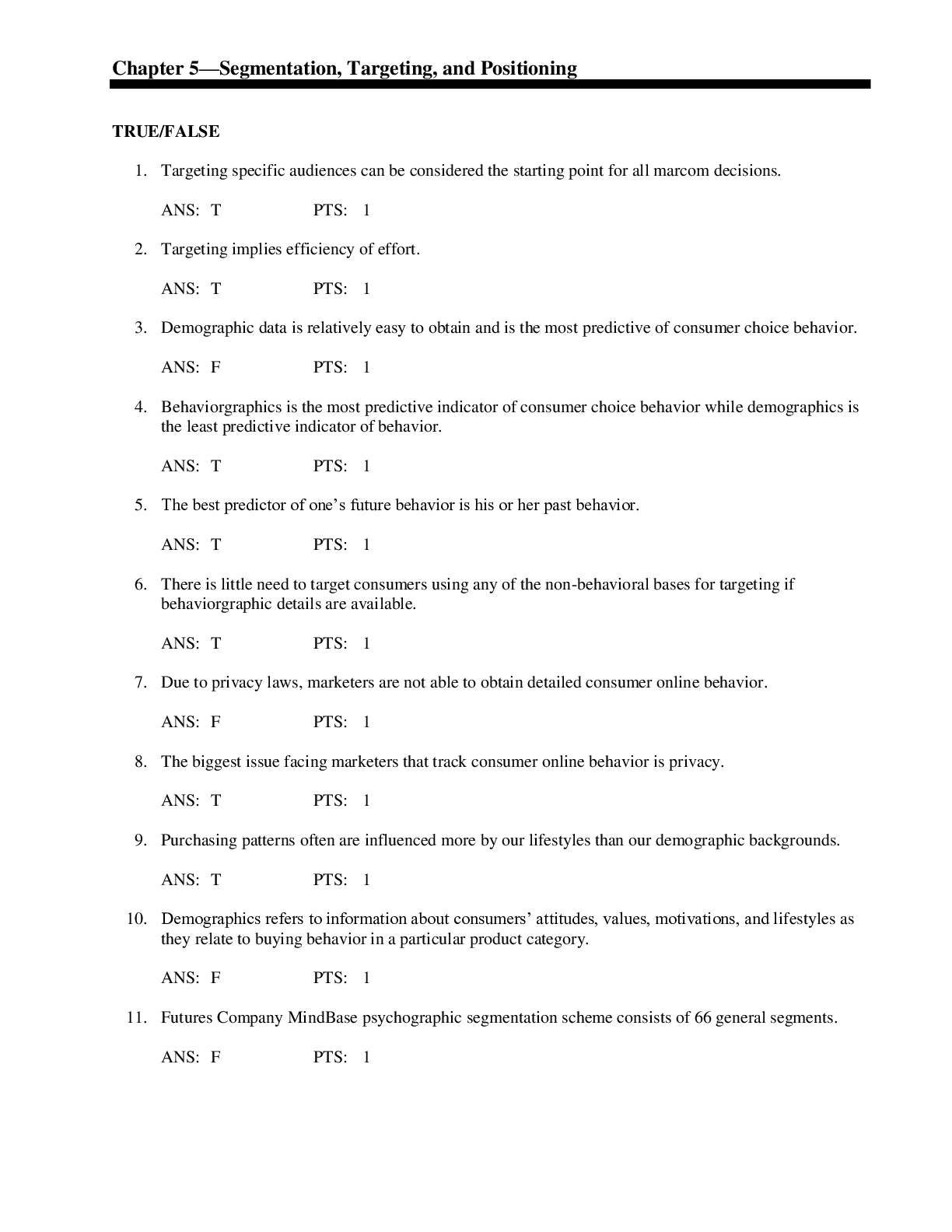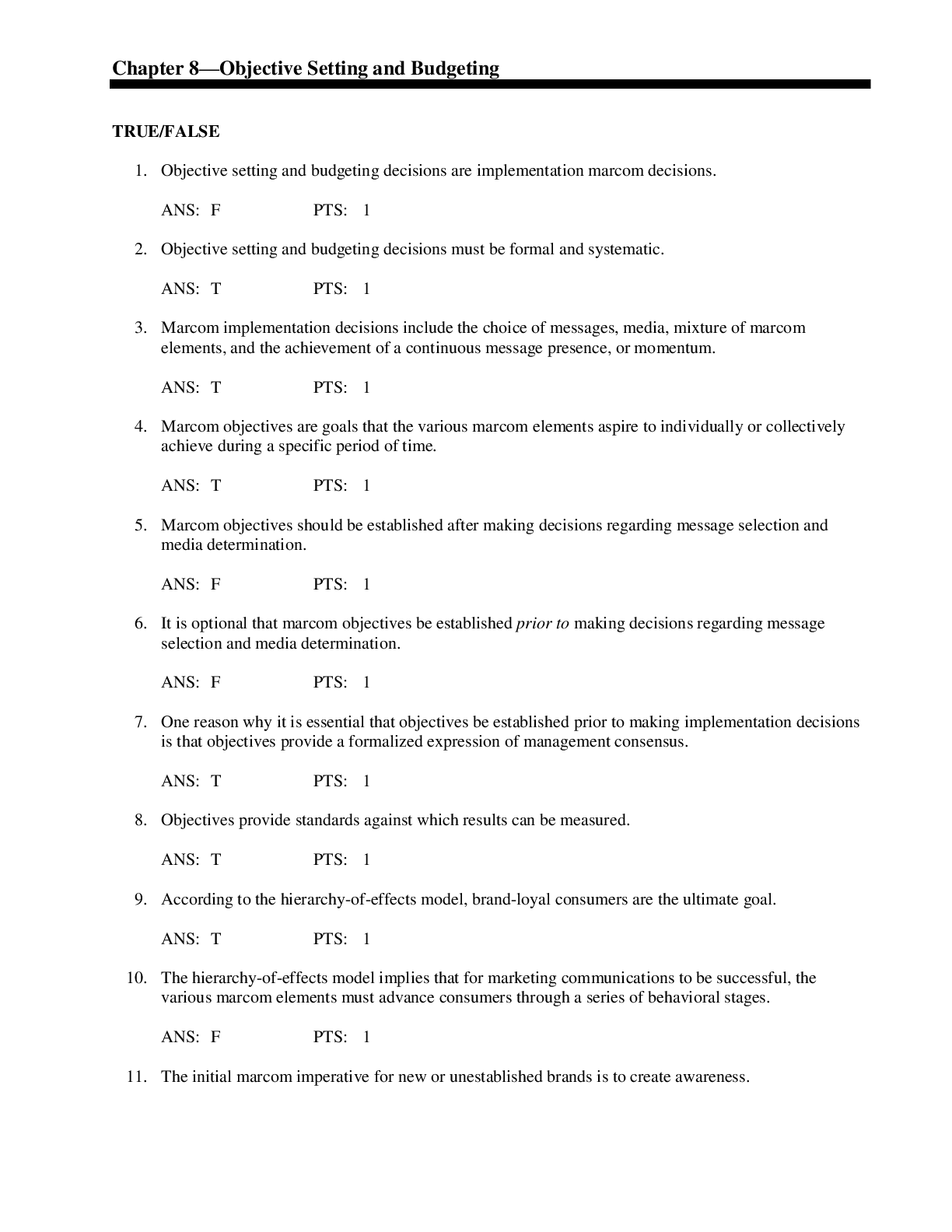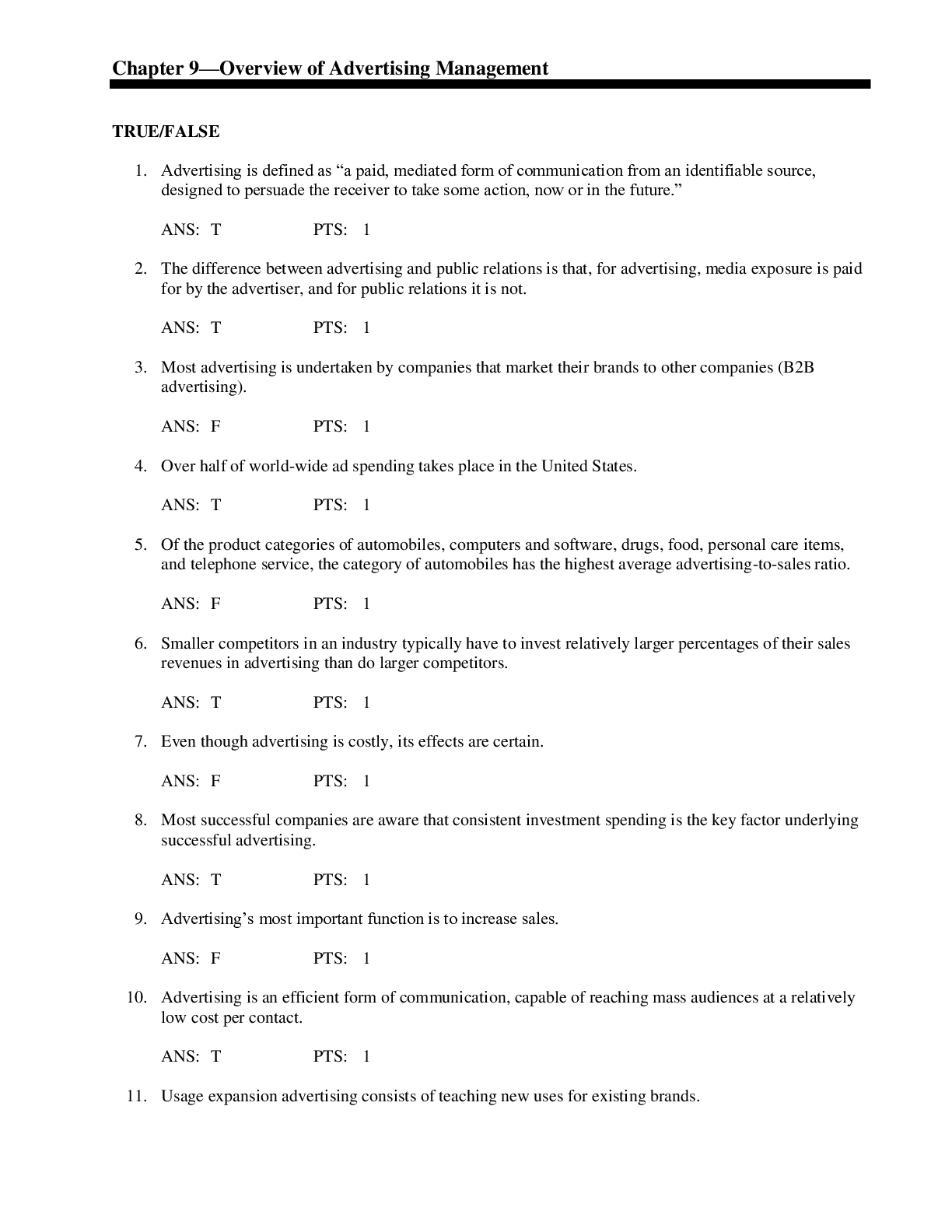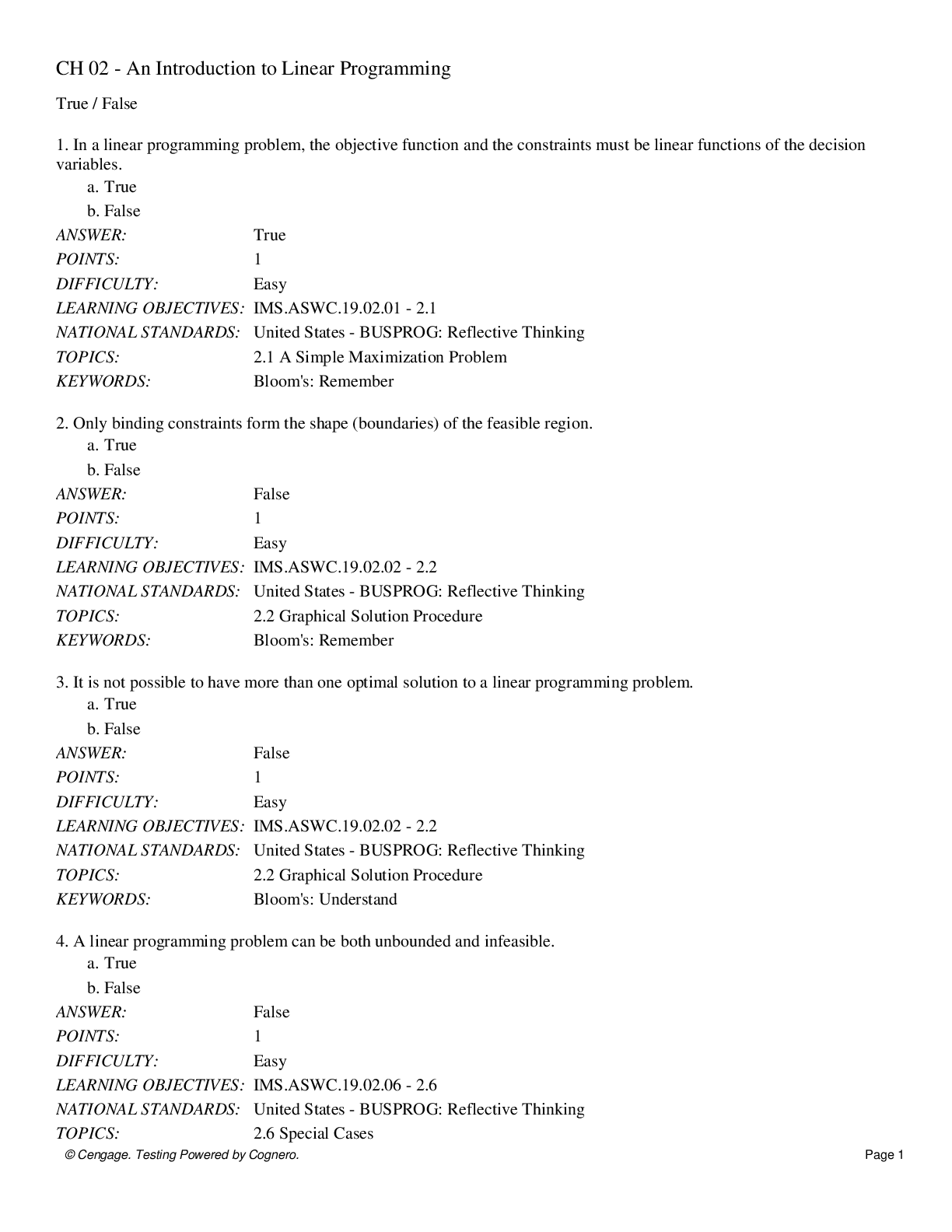Information Technology > QUESTIONS & ANSWERS > WGU C724 Questions and Answers Rated A. Rated A (All)
WGU C724 Questions and Answers Rated A. Rated A
Document Content and Description Below
WGU C724 Questions and Answers Rated A Data ✔✔Symbols or signals that are input, stored, and processed by a computer for output as usable information. Hardware ✔✔the physical equipment and... devices that make up a computer system and are connected by networks. Includes input, output, and storage devices. People ✔✔are the information system professionals and users who use computers Software ✔✔Made up of programs and instructions to run your computer and network. Network ✔✔a system of computers joined together so they can communicate and share resources. Processes ✔✔Processes and procedures provide a structured sequence of activities to govern the use, operation, and maintenance of IS. Executive Information System (EIS) ✔✔This system supports senior executives by providing important data in the form of graphs and charts to analyze and identify long-term trends. Decision-Support Systems (DSS) ✔✔focus on supporting all phases of specific decision-making processes and procedures for arriving at a solution. The Four Components of Decision-Support Systems (DSS) ✔✔data, model, knowledge, and user interface management.Management Information Systems (MIS) ✔✔represent a category of information systems that serve low or first level managers and are usually focused on short- to medium-term business decisions. The Five Components of Management Information Systems (MIS) ✔✔hardware, software, database, network, and people. Transaction processing systems (TPS) ✔✔collect, store, update, and retrieve transaction data within an organization and is used by middle management. Key Performance Indicators (KPI) ✔✔are used by executive and upper management to see how the organization is performing in certain areas. Executive Support Systems (ESS) ✔✔use internal and external data to help executives make unstructured decisions. The Four Components of the Executive Support Systems (ESS) ✔✔hardware, software, user interface, and telecommunications. Information Systems ✔✔an integrated network of components that provide managerial and operational support to businesses by collecting and processing data into useful information as well as providing for storage, retrieval, and security of data and the information it's transformed into. Information Technology ✔✔refers to the hardware and software required to manage and deliver information. Information ✔✔is the meaningful organization of data so that statements can be made about them. Major Reasons Firms Invest in Information Systems ✔✔1. achieve operational excellence 2. develop new products and services3. attain customer intimacy and service 4. improve decision making 5. promote competitive advantage 6. ensure long-term survival 7. develop strong relationships with suppliers An information system can provide solutions to problems and economic value to a business. Information Management ✔✔is concerned with collecting, managing, manipulating, organizing and reorganizing, and distributing information from a variety of sources to a variety of audiences in an organization. Data Cleansing ✔✔ensuring data accuracy and integrity by correcting inaccurate information and deleting erroneous or duplicate data. Information Technology Management ✔✔is concerned with the management of resources that facilitate access to information. Major Business Functions Provided by Information Systems ✔✔accounting and finance Human Resources Production and Operations Sales and Marketing Strategic Information Systems ✔✔provide tools used by an organization to accomplish specific tasks in order to gain a competitive advantage in the marketplace. Porter's 5 Forces Model ✔✔that helps companies develop competitive strategies using Information Systems. Includes new entrants, substitute products or services, bargaining power of customers and suppliers, and competitive rivalry.Value Chain ✔✔a set of inputs used by a strategic information system and put into meaningful outputs to help a company gain a competitive advantage in the marketplace Network Economics ✔✔the cost of adding another business participant to a business venture is small, the potential gain is great. Virtual Company Model ✔✔Networks of people and resources join together to provide a service or create a product without the traditional storefront boundaries. Business Ecosystems ✔✔A network of businesses, such as suppliers and distributors, that are involved in providing delivery of a service or product through cooperation. Network-Based Strategies ✔✔create mutually beneficial partnerships between businesses. Product Differentiation Strategy ✔✔this strategy can include offering a higher quality product or service. a) A core competency is an activity for which a business is a marketplace leader. b) Synergy is the cooperation between several businesses to produce a better product or service than would be possible if each business worked independently. Companies must clearly understand their strengths and weaknesses and join forces with other companies to create positive synergy. Growth Strategy ✔✔can include adding new products or new enhancements to existing products and can also include acquisition, where one business purchases another. Enterprise Resource Planning (ERP) ✔✔systems tightly integrate functional areas such as accounting, finance, project management, inventory control, purchasing, human resources, customer retention, sales, and marketing into one single, comprehensive IT system to allow for more focused system wide decisions.Customer Relationship Management (CRM) Systems ✔✔uses technology to merge marketing with business processes to strengthen customer relationships and organize customer information (likes, dislikes, and previous purchase history). Supply Chain ✔✔is the sequence of processes involved in getting raw materials for a product all the way to the production and distribution of a product into the hands of the customer. Supply Chain Management (SCM) System ✔✔works to increase the efficiency of the process of getting materials developed into the products and pushed out to the customer. Knowledge Management Systems (KMS) ✔✔uses technology such as the Internet, collaboration software tools, and databases, to facilitate the capturing of corporate data and helps companies deal with personnel turnovers and rapid changes. Chief Executive Officer (CEO) ✔✔is responsible for the success or failure of the company, creating the company culture, and setting strategy and vision. Chief Operating Officer (COO) ✔✔oversees the daily operations in a business and communicates the organization's mission statement to employees. Chief Financial Officer (CFO) ✔✔manages the company finances. Chief Information Officer (CIO) ✔✔is the company's top technology leader and focuses on the people and technology needed to run a company and serves as the technology infrastructure manager for the company and oversees information systems matters. Chief Technology Officer (CTO) ✔✔has the responsibility for implementing technology strategies. Chief Security Officer (CSO) ✔✔is concerned with overall security functions for a business.Network and Computer System Administrators ✔✔install and repair computer systems, as well as identify and fix network issues. Information Security Analysts ✔✔are responsible for the security of a company's network, data, and information. Database Administrators (DBA) ✔✔build databases to store data to meet business needs and are responsible for all three functions including focusing on security and access requirements, designing, and performing testing to ensure performance. Database Technical Specialist ✔✔must know how to capture and use the company's data. Web Developers ✔✔are responsible for creating and maintaining a company's website. Computer Programmers ✔✔Someone who writes code to instruct computers to perform certain tasks. Software Engineer ✔✔is a higher level computer programmer. Someone in this position not only writes the code but is responsible for designing a new application, developing specifications, overseeing the implementation, and supporting users after implementation. Computer Support Specialist ✔✔provides technical support to customers and employees through direct interaction or telecommunications. The support could be through training or troubleshooting technical issues. Computer Systems Analyst ✔✔their job is to analyze a user's needs and determine the most efficient and effective solution and they combine their business knowledge with technical expertise.IT Managers, Project Managers, and Architects ✔✔organize, direct, coordinate, and plan ITrelated activities, people, and projects within an organization. Internet of Things (IoT) ✔✔is the network of products (or things) that can be connected through the internet, communicate with each other and with the environment, and transfer data over a network. Platform as a Service (PaaS) ✔✔is the capability provided to the consumer to deploy onto the infrastructure consumer-related or acquired applications created using programming languages, libraries, services, and tools supported by the provider. Infrastructure as a Service (IaaS) ✔✔is the capability provided to the consumer to provision processing, storage, networks, and other fundamental computing resources. Software as a Service (SaaS) ✔✔is the capability provided to the consumer to use the provider's applications running on this kind of infrastructure. Information Technology Infrastructure Library (ITIL) ✔✔is a common set of best practices widely used by businesses to give guidance to companies on how to use IT as a tool for implementing change. Agile Software Development Methodology ✔✔is an operational method by which software developers iteratively gather requirements, plan, design, develop, test, and implement software. Relationship with Business Strategy ✔✔The adoption or construction of an information system must be aligned with the organization's goals. Value Creation Through Technology Use ✔✔Today's computer technologies, such as wireless sensor networks and cloud computing, allow organizations to create added value in nearly every industry and profession. As a result, several industries have been created, along with manyprofessions, jobs, and fortunes. Technology tools have evolved over the years to create value for business by facilitating calculations, documents creation, and graphs. Political and Legal Pressures ✔✔response is to enact policies, complying to standards, and allying with experienced partners. Cultural Pressures ✔✔response is by using ethical business practices, building strong cultural ties with stake holders, socially responsible, enacting sustainable business policies and practices. Technological Pressures ✔✔response to these pressures by planning for improvements to reduce or manage complexity, creating faster and more accurate models to make better decisions, and innovating to sustain competitive advantages, to keep up with competitors, or to enter new markets. Economic Pressures ✔✔response to these pressures by realizing the need to plan for or react to a changing workforce, powerful suppliers, customers, and/or competitors. Project Management ✔✔is the application of planning, organizing, time management, leadership, communication, and problem-solving skills to accomplish an objective and deliverable on time and on budget. Major Components of a Project ✔✔Time, Scope, Resources (cost), and Quality Risk Management ✔✔involves determining the vulnerability, assessing the impact that risk would have if event occurred, evaluating cost/benefit analysis to avoid or transfer the risk, and implementing the plan. Analyze Risk ✔✔first determine the impact to the business should that risk occur and the likelihood that this risk will actually occur.Acceptance Testing Process ✔✔involves end user evaluation and review of the system in order to demonstrate that the system is ready to be rolled out. Risk Mitigation Planning ✔✔where these are planned to be avoided, reduced, accepted, or transferred. Strategies for Managing Project Risk ✔✔1. Risk Acceptance - Accepting that a risk will occur and doing nothing to avoid or prevent it. 2. Risk Avoidance - Developing an alternative plan for achieving objectives by avoiding a specific risk or risk category. 3. Risk Sharing - partnering with groups of individuals who have more experience and who will accept or absorb some of all of the risk involved. 4. Risk Reduction - Acting to reduce the potential for a risk to occur or affect damage to the project. 5. Risk Transference - Shifting risk to another party. Advantages and Disadvantages of Information Management ✔✔1. failures and problems can be spotted before they become too expensive to handle 2. more information can be sorted, summarized, analyzed, and digested for decision making by fewer people. 3. the use of accurate reports and analytical data, both time and money can be saved by better selecting or reworking projects so that they have the best chance for success. 4. organizations must rely on experienced and expensive human and technological resources to create them or on the companies that supply them. 5. integrations into the various sources of data, as well as the data themselves, must be accurate, reliable, and be able to be maintained. Advantages and Disadvantages of Information Technology Management ✔✔1. Brings order to chaos by providing structure, standards, policies, and protocols. 2. an organization can do a better job at competing within its markets, and effectively communicating with its stakeholders.3. Once information technology (computers, peripherals, etc.) is implemented, support for these must be managed to minimize the risk of failure or obsolescence and to ensure that they are being properly used, managed, secured, and maintained by the people that know them. Global Exporting ✔✔all services from the organization's home location means not changing the centralized structure and requiring all but production to stem from the centralized domestic location, including systems and data storage. Multinational Organization ✔✔means that organizational divisions would be headquartered in different locations, whether partially with an international organization or completely with a transnational organization. Multinational franchising, licensing, joint venture, or foreign direct investment, or similarly branded, semi-independent organizations ✔✔are controlled locally but coordinated (perhaps loosely) through the centralized organizations' structure. Information systems and data storage in this model is typically decentralized at each foreign location, or at strategic location(s) in the local region. Challenges to Global Information Systems ✔✔1. Laws that limit information transfer, including trans border privacy and data transfer laws and other regulations. 2. Social and cultural norms. 3. Cultural particularism, which are societal norms instilled in populations that tie them emotionally to local brands or habits. In developing information systems, organizations generally accommodate non-domestic developers by changing the structure of operations in these different ways ✔✔1. Decentralized development, where developers in different locations develop their own solutions independently. 2. Duplicated systems development, where developers in the centralized location develop information systems and tools, which are then intended to be operated on similar systems at each of the international locations (Laudon & Laudon, 2012).3. Networked development, where development and operations are planned, combined, and coordinated between international locations Global Information Systems Business Strategies ✔✔Is any information system which attempts to deliver the totality of measurable data worldwide within a defined context. ENIAC ✔✔30-ton 1,800 ft2 (sometimes called the "Great Brain"), the first general-purpose electronic, digital computer used to calculate artillery ranges UNIVAC ✔✔(room sized) and lighter (15-ton) derivative descendent of ENIAC, this is the first commercially available mainframe Evolution of Computers (Hardware) ✔✔The earliest commercially available electronic, digital computer occupied a 20 foot by 40 foot room and consisted of 18,000 vacuum tubes. Vacuum tubes were replaced by transistors that were replaced by integrated circuits. a) First Generation: Vacuum tubes (1940 - 1956) b) Second Generation Transistors (1956-1963) c) Third Generation Integrated Circuits (1964 - 1971) d) Fourth Generation: Microprocessor (1971-Present) e) Fifth Generation: Artificial Intelligence (Present and Beyond) are bringing us capabilities such as voice recognition Floating Operations Per Second (FLOPS) ✔✔Computing power is increasing as clock speeds get faster and more operations can be performed per second. Evolution of Software ✔✔Before the late 1940s, reprogramming a computer with different instructions consisted of changing manual switches (as in on or off switches), wiring, or using punched cards to reconfigure mechanical components within them. [Show More]
Last updated: 1 year ago
Preview 1 out of 52 pages
Instant download
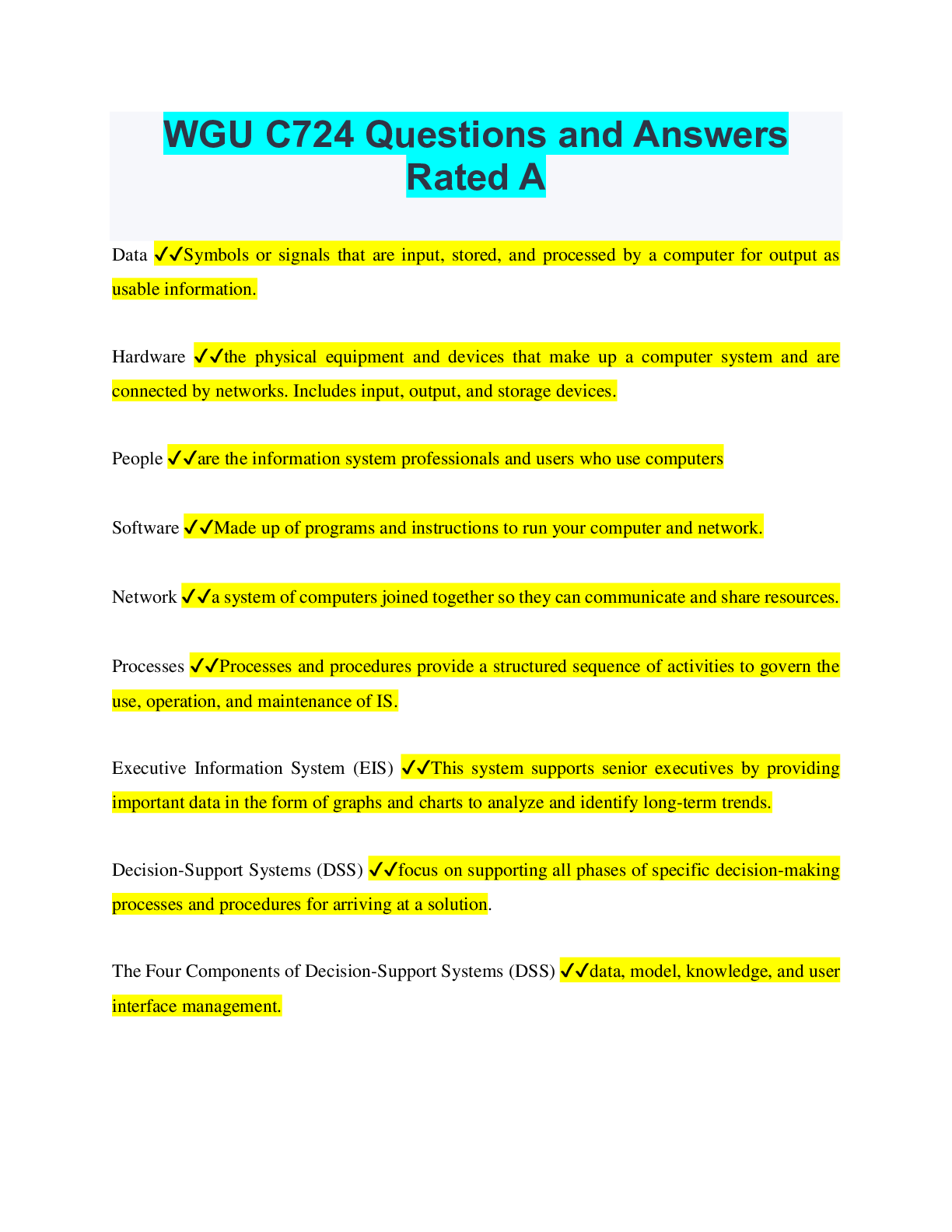
Buy this document to get the full access instantly
Instant Download Access after purchase
Add to cartInstant download
Also available in bundle (2)
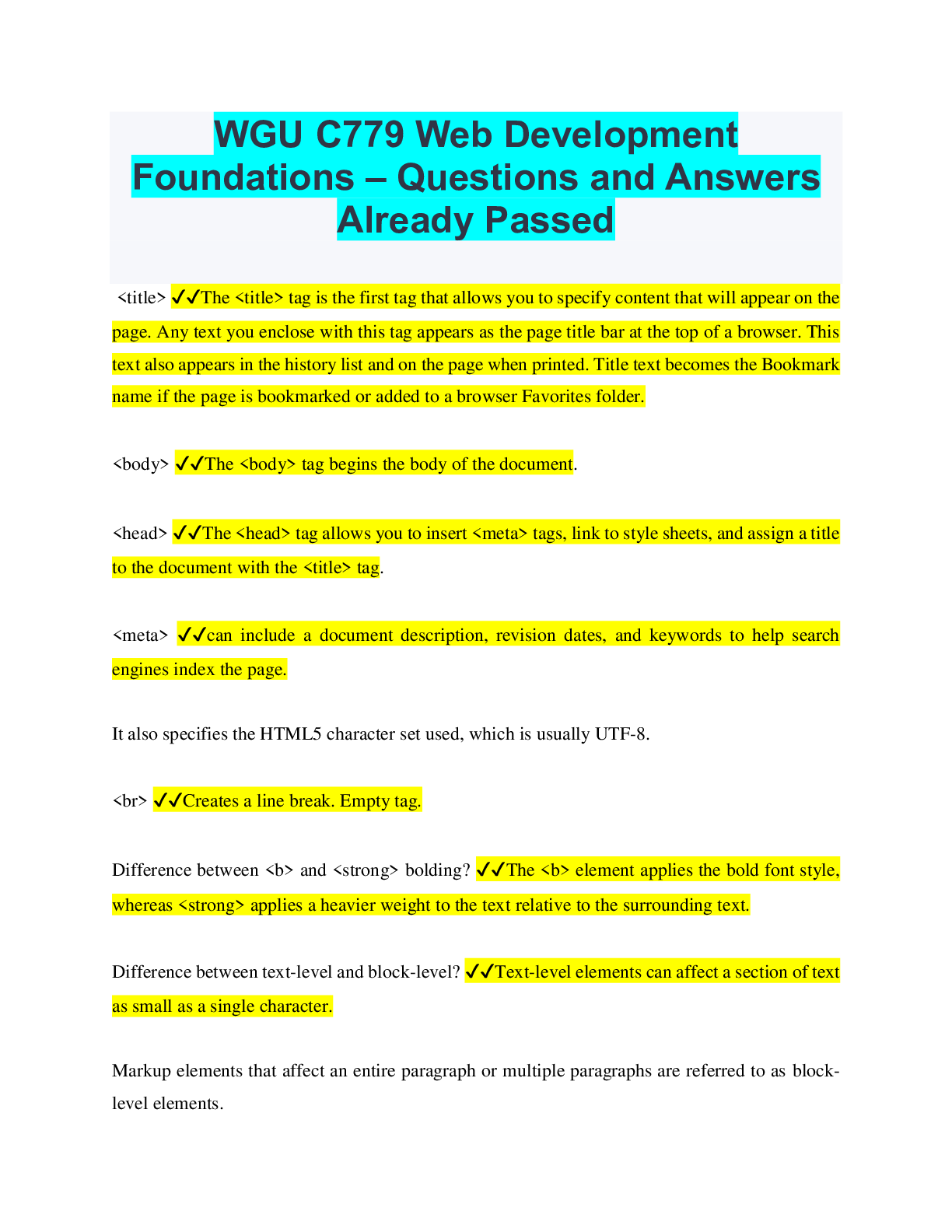
ALL PSYCHOLOGY EXAM QUESTIONS WITH ANSWERS DOCUMENTS. LATEST 2022/2023. RATED A
ALL YOU NEED TO PASS THE PSYCHOLOGY 101. ACCURATE ANSWERS, 100% PRECISE AND EASY READING DOCUMENTS. RATED A
By bundleHub Solution guider 1 year ago
$40
75

WGU C724 BUNDLE, COMPLETE SET TO SCORE A IN EXAMS. ALL QUESTIONS WITH ANSWERS, RATED A. DEEPLY DISCOUNTED
WGU C724 BUNDLE, COMPLETE SET TO SCORE A IN EXAMS. ALL QUESTIONS WITH ANSWERS, RATED A. DEEPLY DISCOUNTED
By bundleHub Solution guider 1 year ago
$28
33
Reviews( 0 )
Document information
Connected school, study & course
About the document
Uploaded On
Sep 30, 2022
Number of pages
52
Written in
Additional information
This document has been written for:
Uploaded
Sep 30, 2022
Downloads
0
Views
108










